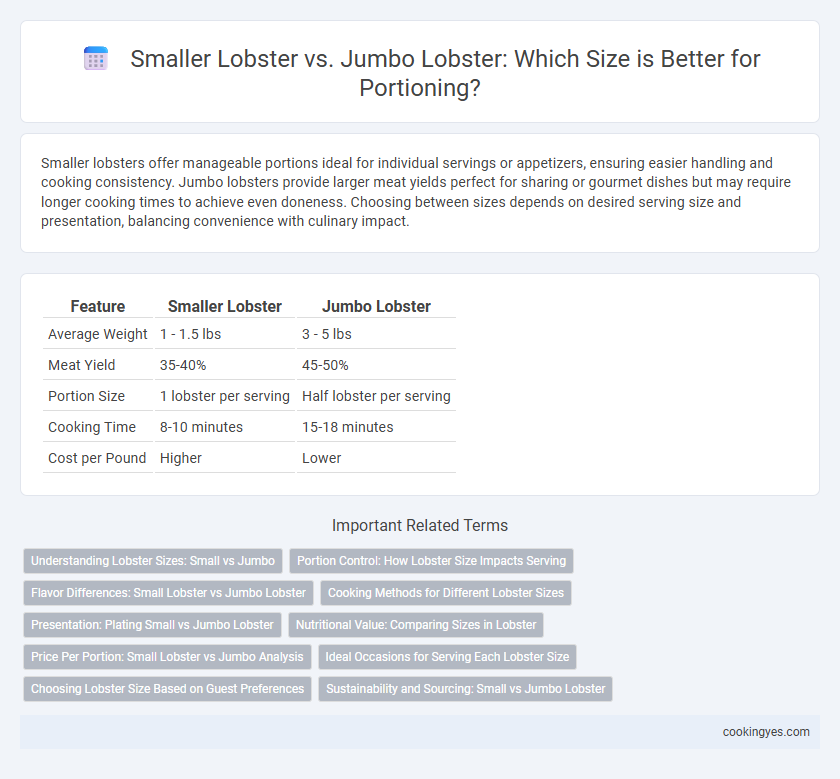Smaller lobsters offer manageable portions ideal for individual servings or appetizers, ensuring easier handling and cooking consistency. Jumbo lobsters provide larger meat yields perfect for sharing or gourmet dishes but may require longer cooking times to achieve even doneness. Choosing between sizes depends on desired serving size and presentation, balancing convenience with culinary impact.
Table of Comparison
| Feature | Smaller Lobster | Jumbo Lobster |
|---|---|---|
| Average Weight | 1 - 1.5 lbs | 3 - 5 lbs |
| Meat Yield | 35-40% | 45-50% |
| Portion Size | 1 lobster per serving | Half lobster per serving |
| Cooking Time | 8-10 minutes | 15-18 minutes |
| Cost per Pound | Higher | Lower |
Understanding Lobster Sizes: Small vs Jumbo
Smaller lobsters typically weigh between 1 to 1.5 pounds, making them ideal for individual portions or delicate dishes due to their tender meat and manageable size. Jumbo lobsters, often exceeding 3 pounds, provide larger portions perfect for sharing or recipes requiring substantial meat, though their texture may vary. Understanding these size differences helps chefs and consumers select the optimal lobster based on portion needs and flavor preferences.
Portion Control: How Lobster Size Impacts Serving
Smaller lobsters, typically weighing 1 to 1.5 pounds, offer precise portion control by yielding manageable meat quantities ideal for individual servings and reducing waste. Jumbo lobsters, often over 3 pounds, provide larger meat portions suitable for group meals but can lead to inconsistencies in serving sizes and potential over-portioning. Selecting lobster size based on desired portion allows chefs to balance presentation, cost, and customer satisfaction effectively.
Flavor Differences: Small Lobster vs Jumbo Lobster
Smaller lobsters generally offer a sweeter and more delicate flavor with tender meat, making them ideal for dishes that highlight subtle seafood nuances. Jumbo lobsters tend to have a firmer texture and a richer, more robust taste, providing a hearty experience perfect for grilling or boiling. Flavor differences between small lobster and jumbo lobster stem from their age and diet, influencing how chefs choose portion sizes based on desired taste profiles.
Cooking Methods for Different Lobster Sizes
Smaller lobsters, typically weighing 1 to 1.5 pounds, cook faster and are ideal for boiling or steaming to preserve their tender texture, usually requiring about 8-10 minutes of cooking time. Jumbo lobsters, weighing 3 pounds or more, benefit from slower cooking methods like roasting or grilling to ensure even heat distribution and prevent toughness while enhancing flavor. Adjusting cooking times and methods based on lobster size ensures optimal texture and taste for each portion.
Presentation: Plating Small vs Jumbo Lobster
Smaller lobsters offer delicate, evenly distributed meat that enhances intricate plating styles, ideal for gourmet presentations emphasizing portion control and aesthetic appeal. Jumbo lobsters provide a dramatic focal point on the plate with their larger claws and tails, allowing for bold, rustic plating that highlights generous servings and visual impact. Chefs often select lobster size based on the desired balance between refined detail and substantial presence in dish presentation.
Nutritional Value: Comparing Sizes in Lobster
Smaller lobsters typically offer a higher meat-to-shell ratio, providing more edible protein per pound compared to jumbo lobsters, which are often prized for their tender tail meat. Nutritionally, both sizes are rich in lean protein, omega-3 fatty acids, vitamin B12, and minerals like zinc and selenium, but portioning smaller lobsters may yield more consistent serving sizes for balanced nutrient intake. Jumbo lobsters, while larger and often more expensive, can result in variable portion sizes that might affect calorie and nutrient control in meal planning.
Price Per Portion: Small Lobster vs Jumbo Analysis
Smaller lobsters typically offer a more economical price per portion, making them ideal for budget-conscious menus and smaller servings. Jumbo lobsters, while commanding a higher price, provide a substantial yield per portion, often preferred for premium dining experiences where presentation and meat volume are crucial. Analyzing cost efficiency, smaller lobsters deliver value through portion control, whereas jumbo lobsters excel in luxury appeal and meat abundance.
Ideal Occasions for Serving Each Lobster Size
Smaller lobsters, typically weighing 1 to 1.25 pounds, are ideal for casual dinners or appetizer servings due to their manageable size and quick cooking time. Jumbo lobsters, often exceeding 3 pounds, suit celebratory occasions or buffet-style meals where a larger portion and impressive presentation are desired. Choosing the appropriate lobster size enhances dining experiences by matching portion needs and event scale perfectly.
Choosing Lobster Size Based on Guest Preferences
Smaller lobsters, typically 1 to 1.5 pounds, are ideal for guests preferring manageable portions with tender meat and a subtle flavor, making them suitable for appetizers or lighter meals. Jumbo lobsters, often exceeding 3 pounds, provide generous meat yields perfect for guests seeking hearty servings or sharing options, offering a robust flavor and impressive presentation. Selecting lobster size should align with guest preferences for portion control, meal type, and desired dining experience to enhance satisfaction and reduce waste.
Sustainability and Sourcing: Small vs Jumbo Lobster
Smaller lobsters generally offer a more sustainable option due to faster population recovery rates and lower environmental impact during harvesting compared to jumbo lobsters, which require longer growth periods and can strain wild populations. Sustainable lobster fisheries prioritize size regulations that protect juveniles and breeding adults, ensuring continuous replenishment while meeting market demand. Choosing smaller lobsters supports responsible sourcing practices by promoting ecological balance and reducing overfishing risks associated with targeting the largest specimens.
Smaller lobster vs jumbo lobster for portioning Infographic

 cookingyes.com
cookingyes.com